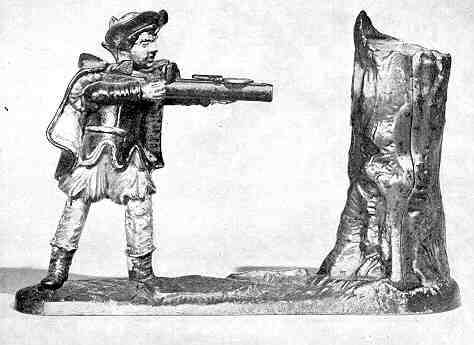New Creedmoor Bank
by F.H. Griffith - HOBBIES Magazine - June, 1976

Patents pertaining to mechanical banks are definitive in most areas of coverage, but at the same time they are often somewhat indefinite in certain areas of coverage. This is particularly true where figures, either human or animal, are concerned. Some leeway was desirable here since it provided flexibility for possible future changes or even in the initial production, should one type figure prove to have advantages over another. Please understand this does not apply to design patents where the configuration of the bank was the coverage.
The New Creedmoor Bank, our choice as No. 263 in the numerical classification, well illustrates the flexibility as to figure coverage. The patent papers covering the New Creedmoor are actually those for the Creedmoor and the figure on each bank is entirely different. Further, the New Creedmoor is an unusual combination, in fact, of two quite different banks, the William Tell and the Creedmoor.
James H. Bowen of Philadelphia, Pa., patented the New Creedmoor Bank November 6, 1877, however, the patent papers show a figure of the type used on the Creedmoor. The patent papers state with respect to the figure: "A toy bank composed of a human or other animal figure." This allowed considerable leeway and at some point during the production of the Creedmoor, Bowen came up with the idea of using the William Tell type figure and the name New Creedmoor.
The Creedmoor Bank with its figure of a soldier enjoyed wide popularity for many years. It is a very proportionate handsome bank, typically a boy’s item, and, of course, the soldier figure had certain appeal. In any case, it is quite logical that after years of production its popularity started to wane and Bowen decided to utilize the very attractive and somewhat flamboyant William Tell figure in place of the soldier. Also, the name New Creedmoor had a certain connotation and actually was a good sales point.
The J. & E. Stevens Company of Cromwell, Conn., manufactured the New Creedmoor, as well as the Creedmoor. They could have been an influencing factor in the development of the New Creedmoor since it enabled them to produce a different mechanical bank with a minimum of effort and expense. The only new pattern required was the base plate, and this change could have utilized the reworking of a Creedmoor pattern base. It was only necessary to change the spread between the feet of the figure, add the word New over the word Creedmoor and obliterate the wording on the other raised section of the base.
The colors of the New Creedmoor are as follows: The base is an all over green with some highlighting in yellow, the two raised sections of the base are dark brown, the tree trunk is a dark reddish brown and the target section is tan with red circular lines. The cape of the figure is black with a red lining and brown collar. He wears a gray hat with red plume. His hair is black and his face and hands are skin tone. He has black eyes and eyebrows. The gun and tunic are black with a red belt and yellow edging on his upper right arm. He wears brown boots, yellow knee length flowing pantaloons, and his leg coverings are a sort of pink color. To complete the coloring, the base is painted green underneath, as is the case with the Creedmoor.
To operate the New Creedmoor, the gun is cocked by pushing back on the top section of the gun. This snaps in place causing the head of the figure to tilt forward as though taking aim. A coin is then placed on top of the gun as shown in photo. The right foot is pressed down and the gun fires the coin into the target on the tree, ringing a bell inside. The head returns automatically to position. The gun is made so that a paper cap could be used, thus giving a loud report when the gun was fired.
The date of the patent, November 6, 1877, appears under the name New Creedmoor on the raised section of the base.
